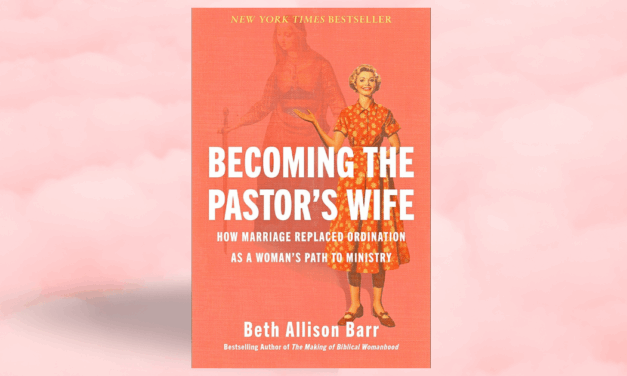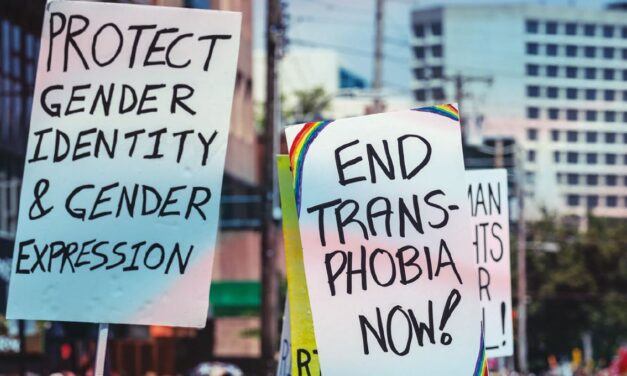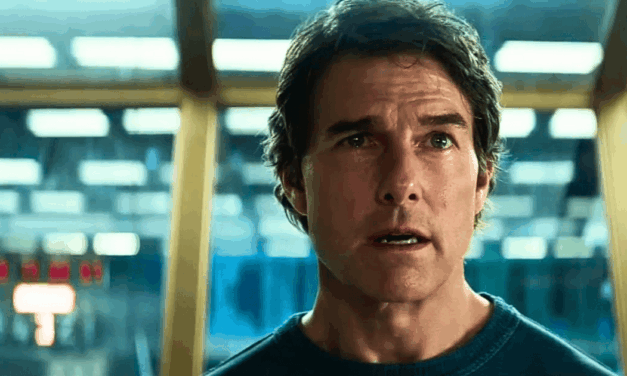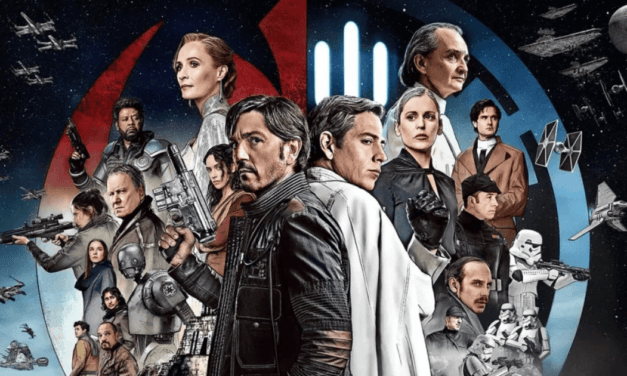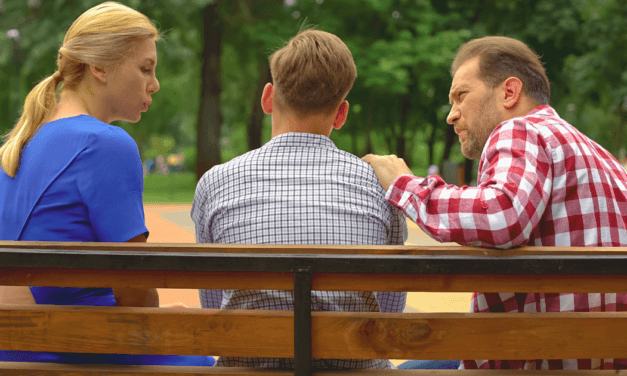This article was published exclusively online in the Christian Research Journal, Volume 48, number 01 (2025).
This is an online article from the Christian Research Journal.
This is a Viewpoint article. Viewpoint articles address relevant contemporary issues in discernment and apologetics from a particular perspective that is usually not shared by all Christians, with the intended result that Christians’ thinking on that issue will be stimulated and enhanced (whether or not people end up agreeing with the author’s opinion).
When you support the Journal, you join the team and help provide the resources at equip.org that minister to people worldwide. These resources include our ever-growing database of more than 2,000 articles, as well as our free Postmodern Realities podcast.
Another way you can support our online articles is by leaving us a tip. A tip is just a small amount, like $3, $5, or $10, which is the cost of a latte, lunch out, or coffee drink. To leave a tip, click here.
SYNOPSIS
Many people today face an identity crisis. Therapy offers an answer: your personality is a trauma response. Originally denoting bodily injury, “trauma” now includes psychological wounds. PTSD, once connected to war or rape, is now also associated with chronic and developmental stressors, like childhood abuse or neglect. Since trauma stems from overwhelming powerlessness and disconnection, vulnerable infant dependence on imperfect parents makes childhood psychological harm almost inevitable. As a result, trauma is no longer a you have it or you don’t binary; it’s a spectrum affecting us all. Our language adapted to be more sensitive to emotional distress. “Therapy-speak” is now rewarded by identity politics: we can be heard in proportion to how much we have been hurt.
In contrast, earlier generations understood suffering through a moral/existential lens, relying on communal and religious practices to navigate pain. They knew identity is formed through community membership and service, not individual discovery. The modern economy amputates communal bonds that once formed our identities; therapy compensates like a clinical prosthesis. The intersection of modern medicine, consumer capitalism, and a problem-solving approach to pain has led to the rise of therapy as a market solution.
Within the church, some Christians view negative emotions as intrusive mental states requiring correction and control through the mental work of “reapplying the Gospel.” Others uncritically embrace therapy for soul development, making emotions sacred and avoiding discussions of sin. But emotions neither reveal our deepest beliefs about God nor our “true selves.” Emotions should be shaped through gradual habit formation that accounts for the way our bodies limit our agency, while holding that change is possible, forming stable virtues. Liturgy, rituals, and embodied church practices train our emotions and recalibrate our behaviors, aligning them with God’s beauty. The church, not therapy, is the true hospital for the soul.
MY ENTIRE PERSONALITY IS A TRAUMA RESPONSE
You have a burning question, but you’re too embarrassed to ask someone in person: what do you do? Ask the internet. Reddit, which boasts half a billion users, is ready and waiting. Designed to combine intimacy and anonymity, Reddit provides a place for people to spill the beans, get some answers, and hear the magic words: Me too. You’re not alone. Try this.
Subreddits on mental health issues abound: r/askatherapist, r/PTSD, r/socialanxiety, r/abusesurvivors, r/neurodiversity, r/depression, r/selfharm, and r/traumatoolbox are just a few. But not only the distressed quench their curiosity on Reddit. Many a more-stable onlooker voices concerns as well: How come everyone seems to have “childhood trauma” these days? Does 100 percent of the population have trauma? Is there an obsession with the word trauma? Indeed. Rumination over trauma is a common feature of social media, and trauma talk is tied to questions of identity. “What horrible things happened to me?” and “Who am I?” have collapsed into the same question. A thirty-seven-year-old female on the r/TalkTherapy subreddit came to this unsettling conclusion:
I am having an identity crisis as I have realized through therapy that my entire personality is essentially a trauma response. I really want to know who I am and have expressed many times to my [therapist] that I don’t feel human, but I’m not really understanding how to become a person. He hammers on how no matter who I am I am worthy of love. I am currently nothing/nobody so how can I be lovable? I really need some help with getting to know myself. Have any of you been offered any tools in therapy to help you understand who you are? In the last three years I’ve only learned who I am not.1
How do we come to feel human, become persons, and understand who we are? The idea that traumatic experiences explored in therapy provide an answer (if not a happy one) is increasingly common. Another woman claimed that “trauma-informed care” left her more traumatized than ever by attributing not only her troubles but her virtues to the abuse she suffered: “It hurt, to be so completely defined by the most terrible moments of my life, especially when my attributes, the things I was proud of; my drive, my passion for justice, my loyalty, my compassion, were also considered traumatic installments. As if the people who took so much from me, who I had fought to be free of, had actually created me….I was merely a product of abuse, nothing was attributable to me, even my good parts were theirs.”2
The idea that the worst parts of life create us and we’re forever beholden to them is relatively new. Looking back to the painful past and looking inward for that elusive self aren’t quite the saving grace that therapy promised us they would be. In the effort to destigmatize disorders and acknowledge the disruptive impact of suffering, the soothing statement Don’t fault yourself, it’s the trauma, implies Don’t credit yourself, it’s the trauma. Are we responsible for anything at all, or are we merely products of our past? Does trauma threaten to destroy our souls, or does it create them?
FROM BODILY INJURY TO ABANDONMENT IN HELL
The ancient Greeks coined τραῦμα (trauma) to refer to physical wounds, a literal usage that held until the nineteenth century, when psychoanalysts began using it metaphorically. They framed trauma as “emotional wounds” and “psychic injuries” requiring time and treatment to heal, much like bodily damage. And yet the source of psychological trauma remained ambiguous: does trauma arise from external factors (what happens to you) or from internal neuroses (how you interpret what happens to you)?
Medical assessments on the battlefield put these concepts to the test. Civil War soldiers suffered from “irritable heart” and “nostalgia,” while some combat veterans were sent to asylums due to paranoia, violent rages, and suicide attempts. World War I brought “shell shock,” and World War II “battle fatigue,” but it wasn’t until 1980 that “post-traumatic stress disorder” (PTSD) was formally included in the Diagnostic and Statistical Manual of Mental Disorders (American Psychiatric Association), based on research involving Vietnam War veterans, Holocaust survivors, and sexual abuse victims.3
Even as psychological trauma became professionally accepted, trauma’s crucial indeterminacy remained: people could experience the same gruesome event, yet their traumatic responses could vary vastly. Brotherly love between soldiers and trust in commanders provided psychological shielding from war trauma. Rape victims who actively resisted retained a degree of agency, resulting in better recovery outcomes.4 Holocaust survivor and psychologist Viktor Frankl insisted that horrific conditions do not automatically produce trauma, but that humans retain their inner freedom to the last: “We who lived in concentration camps can remember the men who walked through the huts comforting others, giving away their last piece of bread. They may have been few in number, but they offer sufficient proof that everything can be taken from a man but one thing: the last of the human freedoms — to choose one’s attitude in any given set of circumstances, to choose one’s own way.”5 Personal agency and relational bonds function like a vaccine against the worst that life throws at us.
According to psychiatrist Judith Herman, psychological trauma afflicts those rendered helpless before an overpowering force, from natural disasters to human atrocities: “Traumatic events overwhelm the ordinary systems of care that give people a sense of control, connection, and meaning.” When there is no way to escape, fight back, or retain dignity against a destructive force, “the whole apparatus for concerted, coordinated and purposeful activity is smashed.”6 Being traumatized combines the conviction I needed rescue with it never came. It is to find oneself abandoned in hell.
THE INFLATIONARY CURRENCY OF TRAUMA
Few contest the reality of psychological trauma caused by war, rape, or natural disasters, but it’s more complicated when harms are chronic rather than acute, developmental rather than sudden, or result from an absent good rather than a present evil. Webster’s Dictionary illustrates this expanding inclusivity: Trauma is a) “an injury (such as a wound) to living tissue caused by an extrinsic agent”; b) “a disordered psychic or behavioral state resulting from severe mental or emotional stress or physical injury”; or c) “an emotional upset.”7
As Danielle Carr writes in “How Trauma Became America’s Favorite Diagnosis,” trauma has become “the inflationary currency through which we transact our lives.”8 When Herman connected acute combat trauma with chronic abuse trauma, she laid the groundwork for expanding trauma from a discrete moment into a prolonged pattern (complex PTSD). The dominant understanding today stems from Bessel A. van der Kolk’s The Body Keeps Score. His conclusion that trauma resides both in the body’s nervous system and in our interpretation have been oversimplified: only the embodied component gets attention.9
Van der Kolk and Herman also introduced the concept of “developmental trauma disorder” stemming from child abuse or neglect. Attachment theory connected big-T trauma (acute) with little-t trauma (chronic, developmental) by maintaining that early caregiver bonds are vital for our flourishing: parental attention turns the chaos of infancy into a coherent consciousness, as face-to-face love literally shapes babies’ brains.10 Unlike adults “rendered helpless” by circumstance, infants are born helpless, dependent on parental competence and goodwill. Expanding trauma’s definition to include developmental stressors seemed scientifically sound, but as Carr writes, it “transformed [trauma] from a ‘you have it or you don’t’ binary into a spectrum. The result is if everyone’s body is keeping the score, what that score actually adds up to starts to get less clear.”11 To say your body is “holding on to the trauma” can provide a scientific sheen to an identity centered on something outside your control: the more embodied it is, the “realer” it seems to others. Diagnosis-as-identity absolves you from the onus of recovery. How come everyone seems to have “childhood trauma” these days? This is why.
Our vernacular is saturated with therapy-speak: triggers, boundaries, safe spaces, inner healing, self-care, self-harm, gaslighting, codependency, toxic, narcissism, repression, attachment style, personality type, identity, coping mechanisms, validation, cognitive dissonance, emotional baggage… the list goes on. We easily turn to therapeutic language denoting pathological extremes to refer to perfectly normal stress responses, or to experiences of suffering that constitute a universal, unavoidable aspect of the human condition. Therapy-speak amplifies the intensity of normal human suffering Princess-and-the-Pea-style, while obscuring from us the older religious practices and interpretations of suffering that once oriented us.12
Our amplified pain is compensated for by the cultural cachet attached to trauma by the rise of identity politics. Our wounds identify us and secure us a platform. We can be heard in proportion to how much we have been hurt, so we savor the sins of our fathers. Righteous activism constructs selves out of the deconstructed sins of our forebears: without the wounds they gave us, who would we be? I was merely a product of abuse, nothing was attributable to me, even my good parts were theirs. To heal, to look outward and forward, to become responsible and embrace the last of the human freedoms — to choose our own way — would be to disappear.
WHY PAY TO TALK TO A STRANGER?
As trauma comes to include more and finer shades of distress, our personal agency and connectedness in the midst of that distress dwindles. We hurt more while coping less. Young people hesitate to have children out of fear of messing them up; adults joke about saving to send their kids to therapy along with college. And while the stigma attached to discussing mental health issues has diminished, that doesn’t account for the ubiquity of self-diagnosed trauma — as if our ancestors also felt this way but simply lacked the social support and words to articulate it. In other times, people used moral and existential language to contemplate their sufferings; they coped through religious and communal means, rather than professional medical means enmeshed in the competitive economics of capitalism.
When therapy became a service, it became a market. Markets always look for new customers. “What could possibly be more profitable than convincing young people they can smooth out all of life’s suffering? That they can heal from being human?” asks Freya India, the Substack GIRLS’s mental health researcher and author. “‘Big Therapy’ tells us the solution to our struggles is to pay a stranger to talk to.”13 Online therapy services like Better Help (“You Deserve to Be Happy”) and TalkSpace (“Therapy for All”), and 24/7 therapeutic AI chatbots like Earkick and Abby, are the next step in the pathologization of human suffering, and in the professional outsourcing of the capacity to cope.
Good therapists (in both senses — morally serious and relationally skilled) are in danger of being sidelined by predatory processes that see potential customers who need “access” to “care” rather than broken people who need to re-learn how to cope with life through face-to-face dialogue. A genuine therapeutic process mirrors the responsive nature of a healthy parent-child relationship in which personal agency is cultivated in the weaker one, and chaos is transformed into communion.14 It also mirrors (one-sidedly) what mature adult friendships naturally foster: the exploration of the questions our suffering poses. Both a market-based approach (which turns people having an identity crisis into therapy customers) and the critical social justice approach (which affirms identities based on emotion and oppression) are a perversion of ethical psychotherapy.
There was a time before therapy set the framework, created the market, and flooded our lexicon; a time when people matured into full-fledged human beings, cared for their souls, coped with suffering, and became themselves — without paying someone else to talk to, without analyzing their mental landscape with a fine-toothed comb, without probing old wounds to discover a “true self.” It has always been hard to be human. What has changed? Why do we need to buy what our ancestors had for free — a satisfying, ready answer to the question, “Who am I?” The desire to assist the natural self-healing of people incapacitated by tragedy, atrocity, and neglect has expanded to fill every square inch of psychic space in our culture. We feel compelled to diagnose every pain, to cure every condition, to destigmatize every abnormality, to affirm every identity, to excuse every failure, and to provide every possible service. The drive to eradicate emotional pain has the potential to swallow our souls alive. My entire personality is essentially a trauma response. I don’t feel human. I am currently nothing/nobody.
A CONTEXT-DEPENDENT HABIT FORMED BY LOVE
Before the rise of the modern centralized nation-state, most people lived in local “hodge-podges of intermarried languages, dialects, laws, customs, and traditions,” small-scale cultures which presumed life was communicable generationally. When families were settled and change was gradual, one generation could apprentice the next in their mode of living. You knew who you were because you could look around and see the people to whom you belonged, the place in which you were situated, and the future you would grow up into (naming generations reveals how far we are from this presumption of heritability: Boomers, Gen-Xers, Millennials, and Gen Z may as well be different species).15
Our modern, mobile, individualistic world insists we do what we’re “passionate” about, discovering ourselves by consulting our feelings. To modern eyes, traditional modes of work and belonging are intolerably oppressive limits on personal autonomy. How could you ever find your true self amidst all these constraints! But limits provide a shape, marking the boundaries of a particular self. A real “somebody” only comes into existence by being knit together with other “somebodies” in a particular “somewhere.” The limits constitute the identity; the traditions solidify the self; the relationship between people and place and memory provides a suite of habits that form an adaptable baby (within the range of its temperament) into a unique and useful adult who belongs.
We dismantled the ties that bind in favor of liberalism’s founding myth, a useful fiction given to us by Hobbes, Locke, and Rousseau: the free, autonomous rights-bearing individual bound only by self-chosen obligations, emerging independent from a “state of nature” to form social contracts it finds reasonable. But real humans do not spring up like mushrooms overnight, fully formed and ready to self-actualize. We do not enter the world autonomous and free, with a glorious train of natural rights and rational thoughts flowing in our wake. Rather, we are born as helpless babies, dependent on our mothers (who depend on others). The fundamental human reality is that we rely on relationships we did not choose, and these relationships form us before we have any concept of consent.16
The modern identity crisis, the mental health crisis, the loneliness epidemic,17 and the “anti-social century”18 of disintegrating communities are different names for the same phenomenon. Instead of conflating the question, “Who am I?” with “What horrible things happened to me?” we should instead be conflating it with questions like these: “Who do I belong to? How am I contributing to their wellbeing? What are my habits and duties? What traditions have been given to me? What am I creating?” As I wrote for the Front Porch Republic:
The whole burning question of identity will begin to fade into the background only when we find a way to belong to one another, to be useful to one another — in the flesh, in a particular place — a decidedly communal and local solution rather than an individual or virtual one. Identity is not discovered by self-examination and then concretized by our purchasing power and verbal declarations; neither is it guaranteed to us by the state (and provided through the market) as a “right.” Identity is first received from the bodies we belong to and from our families who love us into being; it is subsequently forged by one in-the-flesh connection at a time, in the most ordinary of ways, and in the physical place that we find ourselves. Identity is less of a revelation than a slowly built, context-dependent habit formed by love.19
This is good news for the “nothing/nobody” redditor and the woman traumatized by “trauma-informed care.” Identity is not hiding in the rubble of your past, nor was it given to you by your abusers. Identity is not the kind of thing one “finds” like a lost coin, neither is it something we carry around in our heads as an unchangeable deposit. Identity is a habit we create in reciprocal relationship with what and who is around us right now: it is our responsibility in the present. As Wendell Berry describes, “A young person, coming of age in a healthy household and community, will understand her or his life in terms of membership and service.”20 Belonging and contribution impose restraints on individual freedom and construct an identity unobtainable through the pursuit of “self-realization” and “self-fulfillment.” That “special self” we think we can discover by discarding local ways and restraints is just another mass-produced, homogenized consumer of our rootless and placeless monoculture. We moderns traded being somebody, somewhere for anybody, anywhere, which is a fast track to becoming nothing/nobody. “The fact is, one individual person is not a person. Therefore, only a rich relational life — not an obsessively self-analytical one — will make us fully human,” writes ethicist Timothy Patitsas.21
Frankl encouraged Holocaust survivors to fix their attention outwards and upwards, rather than inwards on themselves and backwards on the past. He offered three ways for them to generate meaning, which can form the foundation of identity: 1) by creating a work or doing a deed, 2) by experiencing something or encountering someone, or 3) by the attitude they take toward unavoidable suffering.22 The first two opportunities map neatly onto the agency and connection Herman says are necessary for trauma recovery. But the third opportunity, taking up a new attitude toward suffering, deserves further exploration. Pain doesn’t come to us pre-interpreted, its meaning obvious. Suffering contains questions we must ask and answer. What is wrong? How much longer? Why must I/ought I/should I/can I/ suffer? Why does this kind of evil exist, and why does it strike me?23
WHEN JOB BECOMES PROMETHEUS
The Western tradition contains competing orientations to pain: suffering as a personal action and suffering as an impersonal thing. The Bible is replete with examples of active suffering. To gain skill in the “art of suffering,” bearing up bravely under its weight; to responsibly cope with what cannot be changed; to view one’s suffering as an achievement rooted in patience, perseverance, humility, faith, and wisdom — this is Job’s steadfastness, the Psalmists’ laments, Jesus’s self-sacrifice, and the martyrs’ witness. Within this frame, suffering is a learned skill saturated with meaning and dignity. You can become a virtuoso.
But there is an equally ancient competing narrative: the Promethean myth of stealing fire from the gods. Here, suffering is not a responsibility to bear, but a problem to be solved through knowledge and technique. Pain is a thing we can (and should) eradicate. Prometheus defied Olympus by offering divine fire to a wretched humanity — the source of technological improvement, fostering the birth of civilization’s arts and sciences (a gift he pays for with eternal torture, an ominous ending for a “progress” myth). A Promethean mindset trades personal virtue cultivated within for technical expertise acquired from without: gain the information, apply the method, purchase the product, engage the service, and suffering can be alleviated. Such assumptions undergird the entire scientific enterprise as it intersects with modern medicine and consumer capitalism, creating an anesthetic society dependent on a class of specially-trained experts who function as “pain-killers,” relieving individuals from the fruitful difficulty of being pain-bearers.24
The therapeutic service sector promises to deliver us from the responsibility of answering the questions suffering poses, connecting with the communities that enable us to cope, and cultivating the habits and virtues that make suffering bearable. In his book Limits to Medicine: Medical Nemesis, The Expropriation of Health, philosopher and Catholic priest Ivan Illich rebukes our overmedicalized culture:
Progress in civilization became synonymous with the reduction of the sum total of suffering. From then on, politics was taken to be an activity not so much for maximizing happiness as for minimizing pain. The result is a tendency to see pain as essentially a passive happening, inflicted on helpless victims because the toolbox of the medical corporation is not being used in their favor.
The reminder that suffering is a responsible activity is almost unbearable to consumers….By equating all personal participation in facing unavoidable pain with “masochism,” they justify their passive life-style….In such a society the advocacy of a renewed style in the art of suffering that incorporates the competent use of new techniques will inevitably be misinterpreted as a sick desire for pain….In such an intensely industrialized society, people are conditioned to get things rather than to do them; they are trained to value what can be purchased rather than what they themselves can create. They want to be taught, moved, treated, or guided rather than to learn, to heal, and to find their own way.25
The expectation that health is a noun — something I can get by purchasing it from outside of myself — is a category error, Illich says. Health is not a possession or commodity one pays for; it is a personal ability to rally and adapt. To Illich, “health” designates “the intensity with which individuals cope with their internal states and their environmental conditions.”26 This self-initiated “organic coping capacity,” which historically took place in small local networks of mutual care, is degraded within industrialized society and replaced with professional management.27
The therapeutic language of diagnosis and treatment primes us for the morally neutral world of Promethean problem-solving. The words we use shape the world we see; as Promethean language for suffering expands, it replaces the moral framework embedded in biblical language. This older language was suffused with the possibility of sin, either sin which brought suffering down on one’s head, or the temptation to respond sinfully when tested (although the possibility of innocent suffering is always present, as with Job and Jesus). Biblical language for suffering is complex and relational, expressed in psalms and laments, in arguments with God and prophetic rebukes, in curses on enemies and cries of abandonment, in self-recrimination and pleas for forgiveness, in prayer and promises of future praise. Suffering is envisaged as a wound to be healed, a curse to endure, a just punishment, cosmic labor pains, demonic oppression, a fiery furnace to test one’s faith, a race to be won for the crown, filling up what is lacking in Christ’s afflictions, momentary hardship preparing for us an eternal weight of glory, a burden we bear both personally and together.
What is notably absent from Scripture is any sense of diagnosis, technical removal, problem solving, or anesthetizing. Christ healed the bodies and souls of people He came into contact with during His public ministry, but such healings were intertwined with repentance and forgiveness, the result of a personal encounter with The Resurrection and The Life: they were not “healthcare.” Illich was known for his prayer, “and lead us not into diagnosis, but deliver us from the pursuit of health.”28 At the root of his skepticism towards the modern therapeutic service sector was his conviction that our suffering has an existential, moral, and spiritual dimension which “the pursuit of health” can bypass, which “diagnostic absolution” can short-circuit, to the detriment of our relationship with Christ, our souls’ maturity, and our bonds with others. Illich was not against “the competent use of new techniques” as just one tool among many in our approach to suffering. But he knew that technique must remain below a certain threshold, subservient to a biblical paradigm, or else we will amputate part of ourselves in the pursuit of painlessness.
THE CLINICAL PROSTHESIS FOR AMPUTATED RELATIONSHIPS
Historian Christopher Lasch argued that social bonds which naturally resist the free flow of labor (rooted communities) were destroyed when labor was turned into a commodity, and local subsistence transformed into wages. Industrial capitalism treats people as interchangeable parts, valuing individual freedom over connection to place or community.29 The result is a fragmented society where isolation, loneliness, and competition thrive, as relationships are commodified and converted into services.30 Therapy is a clinical prosthesis for the amputated limbs of friendship, close-knit extended family, and long-term neighborly networks of mutual care. The system that all of us live within can’t help but weaken and break our bonds and sell us substitutes (it’s so much better for the GDP).
Therapy has been responding to the “inflationary currency” of trauma: it has crossed the threshold of counterproductivity, becoming so commodified that it’s no longer a specialist tool for tough cases, but a default treatment for the well-educated. When therapy is billed as a place to work on your communication skills, improve your relationships, manage stress, set personal goals, and increase your productivity and overall satisfaction with life,31 it has left the realm of mental health treatment and is encroaching on the territory of friends, family, mentors, and church. The ability to pay a professional for basic relational support undercuts these economically invisible and naturally-formed networks of care (to the degree they still exist).
Family members who don’t “respect your boundaries” as well as your therapist, or friends who fail to exhibit the “unconditional positive regard” your therapist musters for forty-five minutes each week lose their luster. Estrangement between adult children and their parents is rising, often connected with therapists “empowering” adult children to cut off ties allegedly contaminated by trauma (expansively redefined).32 The therapist’s conversational skill, unflappability, compassion, and undivided attention sets the bar for all unpaid relationships. But therapy is rehab; it is not a subscription service. That’s why any therapist worth their salt will foster relational competencies within the client — self-sufficiency within the client’s personal support networks being the goal — rather than generate dependency upon themselves indefinitely.33
Alan Noble asks in his book On Getting Out of Bed: The Burden and Gift of Living, “What if our contemporary society is not actually built for us, for humans as God designed us? If that is the case, then sometimes anxiety and depression will be rational and moral responses to a fundamentally disordered environment.”34 Today’s mental health diagnoses say less about the state of affairs within our heads than they do about the state of society’s “fundamentally disordered environment.” We would be truly sick if we didn’t respond to these coerced and systemic relational ruptures with depression and anxiety. Is an amputee healthy if he doesn’t miss his limbs? Ours is a psychologically sick-making society,35 and depression is a disease of modernity: “The modern social environment is more competitive, inequitable, and lonely. This deterioration of social cohesion among modern-industrialized populations may be a central component to rising rates of depression,” researchers conclude.36 And still we insist on diagnosing individuals as if they were the source of the problem: over one in five Americans experiences mental illness each year, and the rates keep increasing.37 “People would rebel against such an environment,” Illich writes, “if medicine did not explain their biological disorientation as a defect in their health, rather than as a defect in the way of life which is imposed on them or which they impose on themselves.”38
At the risk of undermining my earlier point — no, we don’t all need therapy — there is something eerily “traumatizing” about our modern way of life, which makes it hard for me to blame anyone who feels the need to seek out a therapist for help, or who gropes for an identity as for a phantom limb. The distress is real because the amputation is real; the necessity for learning to cope and connect is real too. On an individual scale, therapy helps some people struggling with mental illness and relational crises, to the degree it compensates for the natural social cohesion we’ve lost. And yet, if we don’t find a way to optimally limit its reach, we risk further eroding the cultural conditions people need to live a life of natural autonomous healing. Just as the body heals its wounds and fights infection, so does the psyche. The majority of people who exhibit signs of extreme trauma immediately after combat or rape will recover enough to resume normal life within a few months (most PTSD is temporary and self-correcting).39 Would this not be just as true for lesser horrors? Professionals shouldn’t do for us what we can do for ourselves. We need discernment to draw the line between those who need professional help and those who are better off finding their own way in local lay networks of care.
If psychotherapy is the best the world has to offer to address the mental health crisis and identity crisis that so many people are facing, what does the church have to offer? What does trauma have to do with the Christian faith, and to what degree should therapy culture permeate church culture?
FROM THE CHURCH TO THE COUNSELOR’S OFFICE
In the beginning, God created all things good, and humanity very good. But we broke faith with Him, causing a primordial rupture that led to exile and murder (lost connection), along with cursed work, slavery, and death (lost agency). The Gospel — God’s promise to restore communion with Himself and free us from sin and death into eternal life — is divine healing for the collective trauma of the Fall. God answered our cry when we were abandoned and helpless in hell.
God entered our story in Christ, experiencing the trauma of rejection, betrayal, humiliation, torture, and death; He triumphed over trauma in the resurrection. “He himself bore our sins in His body on the tree, that we might die to sin and live to righteousness. By His wounds you have been healed” (1 Peter 2:24 ESV). As Christians we share His sufferings, take up our cross, and follow Him. Christ restores our capacity to love, trust, and obey, giving us “a spirit not of fear but of power and love and self-control” (2 Timothy 1:7 ESV). Through baptism and the Eucharist, we become God’s children, family to one another, commissioned and equipped to extend His redemption to others. The richness and depth of the identity Christianity offers us has no parallel.
All of the promises and potential are here, and yet… the reality on the ground falls short of the promise. The most common response I’ve heard to this tension between “the already and the not yet” in Reformed evangelical circles is to “reapply the Gospel.” This means doing a kind of voluntary mental work, thinking true things and waiting for feelings and behaviors to catch up with that truth. Matthew LaPine, author of The Logic of the Body: Retrieving Theological Psychology, calls this “emotional voluntarism.” It’s the view that we are responsible for emotions as intrusive mental states that show what we truly believe, and that the way to deal with these beliefs/feelings is through mental rehearsal of Gospel propositions.40
But, as LaPine points out, this fails to account for the way that our bodies qualify our emotions and our agency. “The body makes [emotions] less voluntary than actions and more recalcitrant to change.” As anyone who has struggled with anxiety, depression, Obsessive-compulsive disorder (OCD), or PTSD can attest, the body not only “keeps score,” but seems to hold the reins. Symptoms of these disorders are emotional, embodied experiences that are neither fully under our control, nor are they reflective of deep-seated unbelief in God’s love, power, or provision. “The therapeutic recommendations of emotional voluntarism seem hopeless and false,” LaPine writes. “Many chronic sufferers simply cannot repent and believe their way out of the anxiety.” LaPine notes with regret that “there is a path out of the church that runs through the counselor’s office,” where embodied limits are taken more seriously.41
If some churches don’t recognize the degree to which our bodies shape our emotions and limit our agency, others lean hard into a wholesale adoption of therapy culture. “The vast majority of people are not in dire states of mental illness but nevertheless look to therapy rather than to religious tradition for their soul development,” writes Timothy Patitsas. “The mere fact of therapy’s total, unchallenged, and unexamined victory over American inner life should give us pause.”42 As many have noted, Christian worship music commonly focuses on individual healing and emotional security. Chris Tomlin’s “Good Good Father” (and other songs like it) could only have been written from within and for a therapeutic culture. The lyrics are intimate, consoling, emotionally intense, and tailored to speak to the painful identity issues of childhood trauma.43
As Jake Meador (Mere Orthodoxy) describes, there are churches whose discussions of shame draw more from Brene Brown than from Scripture; who promise that “with the help of the enneagram powered by the Gospel you can be transformed”; who avoid the word “sin” and encourage those stuck in bad patterns to “have grace for themselves” and “practice self-care” rather than provide practical help for personal change. Instead of discipling parishioners into Christlikeness, they prioritize making church a “safe space.” Pastors who attempt to lovingly confront congregants over sinful, damaging behaviors are accused of shaming people, even of being emotionally abusive.44
In reaction to past experiences of intense judgement and shame within fundamentalist churches, many now expect a “healthy church” to be a place of no judgment and no shame. God is imagined as a “Divine Butler and Cosmic Therapist,” always on call, solving problems, and professionally helping folks feel better about themselves without pushing too hard on tender spots.45 In “The Christian in a Therapeutic Age,” Ian Harber notes, “The shift from mental health disorders being largely ‘treatable, modifiable, and malleable’ to being an ‘identity’ that ‘gives people a fixed mindset, telling them this is who they are and who they will be in the future,’” has provided Christians a seemingly legit path for opting out of the moral effort involved in being a disciple of Christ.46 Grace means taking it easy and staying “as is.”
A CHURCH OF WOMEN AND MEN WITH CHESTS
Neither emotional voluntarist just-apply-the-Gospel Christians who view emotions with suspicion as something to be controlled, nor the therapeutic Christians who view emotions as a sacred cow to be tiptoed around, appreciate the role of habit. Through a gradual process and intentional effort, unbidden feelings can be formed into stable virtues. Such durable moral change is only possible if we put emotions in their proper place: they neither represent our deepest beliefs or truest thoughts about God, nor do they constitute our identities. Emotions are malleable (able to take a new shape) and durable (subsequently able to hold that shape): this is what makes habit formation possible. Feelings — which arise from our embodied experiences and yet retain a kind of plasticity and experiential responsiveness when governed from the top-down by our reason and will — are changeable. But change isn’t easy or quick, and it’s not accomplished solely by mental work.47
In The Abolition of Man, C. S. Lewis observes, “Without the aid of trained emotions the intellect is powerless against the animal organism.” The tripartite vision of personhood which comes to us from Plato and through Thomas Aquinas, was gutted in the modern era, leaving us only mind and body (an error Lewis addressed). We are composed of eros, thumos, and logos; of appetite, spirit, and reason; or body, heart, and head. That middle layer of thumos/spirit/heart/emotion is what Lewis referred to in his memorable phrase “men without chests.” “In a sort of ghastly simplicity we remove the organ and demand the function. We make men without chests and expect of them virtue and enterprise….We castrate and bid the geldings be fruitful.”48 The emergence of therapy culture and its simultaneous rejection and uncritical adoption by different portions of the church reveals how necessary it is that we recover the possibility of “trained emotions,” habit formation, and virtue ethics.
We can exercise a degree of agency over who we become by choosing where we direct our attention, reframing our experiences through language, construing the meaning of our sufferings one way rather than another, forming bonds with others, and placing ourselves in the path of certain embodied experiences. We are neither stuck forever in the feelings of today (like those who identify with trauma or mental illness), nor capable of transformation with a snap of our fingers through “faith” (emotional voluntarism). Lapine describes this complex middle way:
On my model, mental illness is not strictly biological, nor is it strictly psychological. Mental illness is a vicious psycho-physio feedback loop producing distress. It is also social, as our experience with others is the single most important experiential factor in mental health….This conception of mental illness collapses the disjunction between illness and wickedness, yielding a more complex picture of ourselves as both sinful and dysfunctional.49 (emphasis added)
We cannot repent our way out of mental illness or traumatic disorders, as if they were simply psychological sins or false beliefs to be left at the foot of the cross. Neither are they purely physical experiences like cystic fibrosis or epilepsy, for which we bear no moral culpability and cannot change. The truth lies in the messy middle of experiential and emotional embodiment. When used with discernment within the biblical grammar of suffering, therapy can assist with reinterpreting our emotions so we can cope and recover. “A significant benefit of counseling is reframing the story of what we are feeling. Counselors bring comfort because the way we explain our emotion to ourselves makes a great difference to how we experience it,” LaPine writes.50
A primary aim of Christian teaching and church liturgy, rituals, sacraments, and devotional practices, is to foster construals of our pain that align with who God says we are, and to craft experiences that help us feel it deep in our bones. This creates a positive feedback loop: I decide what to attend to; I willingly engage in certain experiences; what I subsequently see and feel nudges me in a certain direction which I know to be more functional, more beautiful, more holy. Because of the continuity between cognition, emotion, biology, and the environments we’re embedded in, we engage in this complex behavior of “niche construction,” modifying our environments, which we then adapt to, triggering transformation. Our churches are “niches” we create and participate in: we will adapt to what we make. If our liturgies and practices are thinned out, then a “propositions only” faith is perfectly adapted to that body-neglecting environment.51 As I wrote for the Christian Research Journal in “Carl Jung and the Modern World’s Wound,”
When much of the American church…has been reduced to “four bare walls and a sermon,” there is plenty for the conscious mind to think about, but little for the body to do, or for the unconscious to experience. Jung thought every religion has two feet — faith and ritual — but Protestantism hops on one foot more often than not….What the Reformers amputated re-emerged as a phantom limb in the form of depth psychology. Therapeutic “priests” now provide us with the healing and self-transcendence that was once the province of church sacraments, spiritual practices, and the heavenly hierarchy. The body and the unconscious (which are so deeply connected) must play their part in the faith.52
The church’s therapeutic turn is a recognition of a genuine loss, a groping for something that is actually indigenous to the Christian tradition: liturgical worship rituals and embodied spiritual practices with the power to sanctify us, to equip us with habits that both honor and train our emotions, and to provide us a holistic identity in Christ. The church has the Spirit-given capacity to “restore the organ” of thumos which modernity has stripped away. We have the responsibility to help people train their hearts with patience, gentleness, firmness, and a sense of humor.
What we need most won’t be found in the rubble of a painful past — in the blaming of those who raised us or ruined us — but in turning our attention outward and upward to the One who is the most Beautiful. Only in beholding Beauty do we become beautiful, good, and true: sustained attention only on trauma will diminish us into nobodies and leave us with nothing. “The great hospital for the soul is liturgy,”53 not therapy, nor the merely mental work of “thinking Gospel thoughts.”
The symbols of God’s beauty that live in art, communal rituals, liturgies, music, stories, parables, sacred spaces, local traditions, sacraments, and Scripture, enable us to immerse our whole selves in grace, which is not a “pass” from the call to change but is rather spiritual nourishment for change. These communal habits recalibrate us behind the scenes of our conscious minds, kindling our thumos for God and brotherly love for each other. Beauty in all these forms weaves the ill-matched threads of our conscious minds, our involuntary emotions, and our unruly bodies into a single cloth. Through the complex niche of the church’s spiritual life, liturgy, and practice, God reaches down to tuck a finger under our chins and gently raises our eyes to meet His gaze.
“But you, O LORD, are a shield about me, my glory, and the lifter of my head” (Psalms 3:3 ESV).
Alisa Ruddell is a staff writer and associate editor for the online magazine Christ and Pop Culture and has previously published at Front Porch Republic, Salt and Iron, and Christian Research Journal.
- Fr0zenFawn, “Tools for Finding Out Who I Am,” Reddit, r/TalkTherapy, accessed February 12, 2025, https://www.reddit.com/r/TalkTherapy/comments/106btm9/tools_for_finding_out_who_i_am/.
- WrenAves, “‘Trauma-Informed Care’ Left Me More Traumatised Than Ever,” PsychIsDrivingmeMad, August 16, 2022, https://www.psychiatryisdrivingmemad.co.uk/post/trauma-informed-care-left-me-more-traumatised-than-ever.
- “History of PTSD in Veterans: Civil War to DSM-5,” PTSD: National Center for PTSD, VA.gov | Veterans Affairs, n.d., accessed February 3, 2025, https://www.ptsd.va.gov/understand/what/history_ptsd.asp.
- Judith L. Herman, Trauma and Recovery: The Aftermath of Violence — From Domestic Abuse to Political Terror (Basic Books, 2015), 34–36, 63.
- Viktor E. Frankl, Man’s Search for Meaning (1946; Pocket Books, 1985), 86.
- Herman, Trauma and Recovery, 48–51.
- “Trauma,” Merriam-Webster Dictionary, accessed February 3, 2025, https://www.merriam-webster.com/dictionary/trauma.
- Danielle Carr, “How Trauma Became America’s Favorite Diagnosis,” Intelligencer, July 31, 2023, https://nymag.com/intelligencer/article/trauma-bessel-van-der-kolk-the-body-keeps-the-score-profile.html.
- Bessel A. van der Kolk, The Body Keeps the Score: Brain, Mind, and Body in the Healing of Trauma (Penguin Books, 2015).
- “InBrief: The Science of Neglect,” Center on the Developing Child at Harvard University, YouTube, October 31, 2013, https://www.youtube.com/watch?v=bF3j5UVCSCA.
- Carr, “How Trauma Became America’s Favorite Diagnosis.”
- Allie Volpe, “The Limits of Therapy-Speak,” Vox, June 25, 2023, https://www.vox.com/even-better/23769973/limits-therapy-speak-narcissist-gaslighting-trauma-toxic.
- Freya India, “No, Not Everyone Needs Therapy,” GIRLS (blog), November 7, 2023, https://www.freyaindia.co.uk/p/no-not-everyone-needs-therapy.
- J. P. Marceau, “A Way Out of the Meaning Crisis,” The Symbolic World, February 10, 2025, YouTube, minute mark 49:31, https://youtu.be/JAZqHMvEEG8?si=e1jidSjTtpIxbOi3&t=2971
- Marc Barnes, “Against Naming the Generations,” New Polity, August 1, 2023, https://newpolity.com/blog/against-generations.
- Alisa Ruddell, “The Beautiful Community and Brutal Scapegoating in the Peasants,” Christ and Pop Culture, February 21, 2024, https://christandpopculture.com/beautiful-community-brutal-scapegoating-peasants/.
- Matthew Shaer, “Why Is the Loneliness Epidemic So Hard to Cure?: Maybe Because We Aren’t Thinking About It in the Right Way,” The New York Times, August 27, 2024, https://www.nytimes.com/2024/08/27/magazine/loneliness-epidemic-cure.html.
- Derek Thompson, “The Anti-Social Century,” The Atlantic, January 8, 2025, https://www.theatlantic.com/magazine/archive/2025/02/american-loneliness-personality-politics/681091/.
- Alisa Ruddell, “Gendered Worlds: Our Need for Belonging and Usefulness,” Front Porch Republic, October 10, 2024, https://www.frontporchrepublic.com/2024/10/gendered-worlds-our-need-for-belonging-and-usefulness/#comments.
- Wendell Berry, Sex, Economy, Freedom and Community: Eight Essays (Pantheon, 1993), 16.
- Timothy G. Patitsas, The Ethics of Beauty (St. Nicholas Press, 2020), 218.
- Frankl, Man’s Search for Meaning.
- Ivan Illich, Limits to Medicine: Medical Nemesis: The Expropriation of Health (1975; Marion Boyars, 1995), 142.
- Illich, Limits to Medicine, 160.
- Illich, Limits to Medicine, 151–53, 214.
- Illich, Limits to Medicine, 7.
- Illich, Limits to Medicine, 127.
- See David Cayley, Ivan Illich: An Intellectual Journey (Penn State University Press, 2021).
- Christopher Lasch, “Conservatism Against Itself,” First Things, April 1990.
- Joseph Chamie, “Living Alone in America,” The Hill, July 19, 2021, https://thehill.com/opinion/finance/563786-living-alone-in-america/. In 1850, less than one in one hundred American adults lived alone; today about one in seven American adults lives alone.
- Ryan Gates, “Why Everyone Can Benefit from Therapy,” HealthCore Clinic, October 21, 2024, https://healthcoreclinic.org/2023/01/27/why-everyone-can-benefit-from-therapy.
- Daniel de Visé, “One Quarter of Adult Children Estranged from a Parent,” The Hill, July 19, 2023, https://thehill.com/blogs/blog-briefing-room/4104138-one-quarter-of-adult-children-estranged-from-a-parent/.
- Emi Nietfeld, “I Needed Help with a Very Specific Problem. My Therapist Was Way Off-Base,” Slate Magazine, August 31, 2024, https://slate.com/technology/2024/08/sexual-assault-treatment-talk-therapy-prolonged-exposure-recovery.html.
- Alan Noble, On Getting Out of Bed: The Burden and Gift of Living (InterVarsity Press, 2023), 13.
- “Burnout — When Does Work Start Feeling Pointless?,” DW Documentary, YouTube, April 27, 2024, https://www.youtube.com/watch?v=raVms8w61No.
- Brandon H. Hidaka, “Depression as a Disease of Modernity: Explanations for Increasing Prevalence,” Journal of Affective Disorders 140, no. 3 (November 2012): 205–214, https://doi.org/10.1016/j.jad.2011.12.036.
- “Mental Illness,” National Institute of Mental Health (NIMH), September 2024, https://www.nimh.nih.gov/health/statistics/mental-illness#part_2632.
- Illich, Limits to Medicine, 169.
- Sebastian Junger, “How PTSD Became a Problem Far Beyond the Battlefield,” Vanity Fair, May 7, 2015, https://www.vanityfair.com/news/2015/05/ptsd-war-home-sebastian-junger.
- Matthew A. LaPine, The Logic of the Body: Retrieving Theological Psychology (Lexham Press, 2020), 4–5, 31.
- LaPine, The Logic of the Body, 36.
- Patitsas, The Ethics of Beauty, 189.
- See lyrics at “Good Good Father,” Life 102.5, accessed March 24, 2025, https://www.life1025.com/songs/good-good-father/.
- Jake Meador, “Church and ‘the Therapeutic,’ Ctd. — Commonplaces,” Mere Orthodoxy, November 3, 2022, https://mereorthodoxy.com/jake/church-and-the-therapeutic-ctd.
- Christian Smith and Melinda Lundquist Denton, Soul Searching: The Religious and Spiritual Lives of American Teenagers (Oxford University Press, 2005).
- Ian Harber, “The Christian in a Therapeutic Age,” Mere Orthodoxy, November 14, 2024, https://mereorthodoxy.com/the-christian-in-a-therapeutic-age.
- LaPine, The Logic of the Body, 17.
- C. S. Lewis, The Abolition of Man (HarperCollins, 2001), 24, 26.
- LaPine, The Logic of the Body, 318–19.
- LaPine, The Logic of the Body, 31.
- Alisa Ruddell, “Why Truth-Loving Christians Still Have a B.S. Problem (and What We Can Do About It),” Christ and Pop Culture, March 20, 2020, christandpopculture.com/why-truth-loving-christians-still-have-a-b-s-problem-and-what-we-can-do-about-it/.
- Alisa Ruddell, “Carl Jung and the Modern World’s Wound,” Christian Research Journal 46, no. 01/02 (2023), www.equip.org/articles/carl-jung-and-the-modern-worlds-wound/.
- Patitsas, The Ethics of Beauty, 201.


